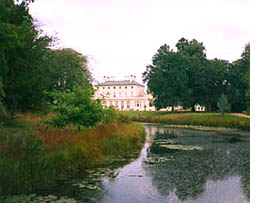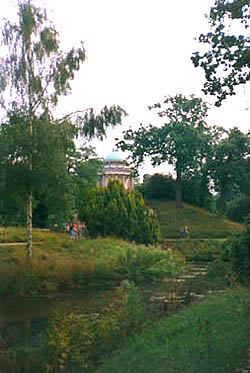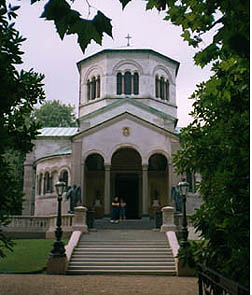Frogmore House: A Royal Family Home
by Tori V. Martínez
 While more than a million visitors each year file through imposing Windsor Castle, a retiring monument to royal family life goes virtually unnoticed less than a mile southeast. Located in the aptly named Home Park in Berkshire, the entire Frogmore estate might simply be the hereditary home of an important upper class English family, and, in a sense, that's exactly what it is. Royal though they were, generations of Britain's premier family chose to spend as much time as possible acting like a "normal" family at Frogmore House. In time, it became such a beloved royal residence that many royal family members chose to make the estate their final resting place.
While more than a million visitors each year file through imposing Windsor Castle, a retiring monument to royal family life goes virtually unnoticed less than a mile southeast. Located in the aptly named Home Park in Berkshire, the entire Frogmore estate might simply be the hereditary home of an important upper class English family, and, in a sense, that's exactly what it is. Royal though they were, generations of Britain's premier family chose to spend as much time as possible acting like a "normal" family at Frogmore House. In time, it became such a beloved royal residence that many royal family members chose to make the estate their final resting place.
So private is Frogmore House that it was opened to the public for the first time in 1990 and is today only open to visitors for a few days in May and August. But while Frogmore can be difficult to access, it is well worth the trouble. The house itself is filled with intimate memories, especially of its times as a creative outlet for repressed Georgian princesses, a country retreat for assorted royals, and a museum for sentimental queens. Enveloping the house are acres of gardens -- carefully manicured in parts, beautifully wild and overgrown in others -- filled with trees of all descriptions and mirrored by a lake and various streams. Exploring the grounds via the many walking paths and bridges reveals the hidden gems of Frogmore -- the many small buildings that dot the landscape, including Queen Victoria's Tea House, a so-called Gothic Ruin, and of course, the mausoleums.
Charlotte's Retreat
Although Crown property since it was purchased by King Henry VIII in the 16th century, the Frogmore estate was not originally occupied by royalty, but was leased to tenants for 250 years. Even without royal residents, the land was significant enough that Shakespeare set a scene in "The Merry Wives of Windsor" in a "field near Frogmore." And, yes -- the estate did indeed get its name thanks to a proliferation of frogs in the marshy grounds. So prolific, in fact, that Queen Victoria once commented about a picnic at Frogmore, "The frogs were quite dreadful, making the grass look as if it were alive."
 In 1680, royal architect Hugh May built Great Frogmore -- the precursor to Frogmore House -- for his nephew, Thomas May, whose wife's family held the lease to the estate. Between 1709 and 1738, Great Frogmore was leased to the Duke of Northumberland, the illegitimate son of King Charles II and the Duchess of Cleveland. Another house on the estate, Little Frogmore, was purchased for Queen Charlotte, wife of King George III, in 1790. Two years later, Great Frogmore was also acquired for the Queen, who demolished the smaller Little Frogmore and went about improving Great Frogmore, which was renamed Frogmore House. According to Frogmore's official guidebook, architect James Wyatt created a royal retreat "where the Queen and her daughters could enjoy their favourite pastimes -- painting, drawing, japanning and needlework, reading, music and above all 'botanising' -- in privacy and tranquility."
In 1680, royal architect Hugh May built Great Frogmore -- the precursor to Frogmore House -- for his nephew, Thomas May, whose wife's family held the lease to the estate. Between 1709 and 1738, Great Frogmore was leased to the Duke of Northumberland, the illegitimate son of King Charles II and the Duchess of Cleveland. Another house on the estate, Little Frogmore, was purchased for Queen Charlotte, wife of King George III, in 1790. Two years later, Great Frogmore was also acquired for the Queen, who demolished the smaller Little Frogmore and went about improving Great Frogmore, which was renamed Frogmore House. According to Frogmore's official guidebook, architect James Wyatt created a royal retreat "where the Queen and her daughters could enjoy their favourite pastimes -- painting, drawing, japanning and needlework, reading, music and above all 'botanising' -- in privacy and tranquility."
It was in this manner that Queen Charlotte and her daughters made the first and most enduring impact on Frogmore House. The king and queen's third daughter, Princess Elizabeth, in particular, was an accomplished artist and her talent is still much in evidence at Frogmore House today. In the 1790s, the princess painted six panels that beautifully decorate the walls of the Cross Gallery. She also worked with James Wyatt to design the Gothic Ruin on the estate. The queen and her daughters passed many pleasant hours at Frogmore and a number of elaborate parties were held there, but the house gradually became a place where the queen quite literally escaped from the torments of her husband's mounting "insanity," brought on by the disease porphyria. When the queen died in 1818, the Frogmore estate passed to her daughter, Princess Augusta, who never married.
By the time of Princess Augusta's death in 1840, the pattern of Frogmore House as the domain of women had been firmly established. And, with a young queen regnant on the British throne, a similar future seemed assured. In 1841, Queen Victoria offered the use of Frogmore House to her mother, the Dowager Duchess of Kent. The duchess certainly considered Frogmore a retreat, but unlike Queen Charlotte before her, she actually lived in the house, so it was modernized and redecorated to fit her needs. Today, the Green Pavilion is the only room in Frogmore House open to the public that remained untouched and is almost exactly as it was in Queen Charlotte's time.
A Royal Tomb
In the 1850s, construction began on a "temple" in the grounds of the estate. The top portion of the finished building was intended to serve as a summer house for the duchess during her lifetime, while the lower level was destined as her final resting place. The duchess died before the summer house was completed, but she was interred there and the building is now known as The Duchess of Kent's Mausoleum. The beautiful blue domed roof of the mausoleum can be seen from the grounds at Frogmore, but it is not open to the public. When the duchess died at Frogmore House on March 16, 1861, Queen Victoria was at her bedside. For weeks afterward, the Queen sat in her mother's bedroom at Frogmore House and sifted through her belongings, all the while insisting that everything remain exactly as it was during her mother's life. Her mourning was so intense that rumors began circulating in London that she had gone mad. In reality, her behavior only foreshadowed the even more extreme response to her husband's untimely death from typhoid just nine months later at nearby Windsor Castle.
 After losing both her mother and husband in such a short period of time and in close physical proximity, it's a wonder Queen Victoria didn't abandon Frogmore House altogether. Instead, she seems to have found comfort in the house and grounds. With her mother interred at Frogmore, the queen focused on making arrangements to have a mausoleum built for Prince Albert and herself. Work began on the Royal Mausoleum in 1862 and was completed in 1871, although the prince's remains were interred there in 1868. After her own death in 1901, Queen Victoria was interred next to her husband. Since then, the royal couple -- represented by their marble tomb effigies, which were created at the same time -- sleeps side-by-side in eternal peace.
After losing both her mother and husband in such a short period of time and in close physical proximity, it's a wonder Queen Victoria didn't abandon Frogmore House altogether. Instead, she seems to have found comfort in the house and grounds. With her mother interred at Frogmore, the queen focused on making arrangements to have a mausoleum built for Prince Albert and herself. Work began on the Royal Mausoleum in 1862 and was completed in 1871, although the prince's remains were interred there in 1868. After her own death in 1901, Queen Victoria was interred next to her husband. Since then, the royal couple -- represented by their marble tomb effigies, which were created at the same time -- sleeps side-by-side in eternal peace.
Whether Queen Victoria liked it or not, life continued on after Prince Albert's death, and she and the royal family maintained close connections with Frogmore. On January 8, 1864, the queen's daughter-in-law, Princess Alexandra, gave birth two months prematurely to an heir, Prince Albert Victor, who weighed only three and three-quarter pounds. As the eldest son of the Queen's eldest son, little Prince Albert was second in line to the throne and, therefore, an exceptionally important addition to the royal family. Tragically, the prince died barely a week after his 28th birthday in 1892. The prince's death also came only days before he was to marry Princess May of Teck, who instead married his younger brother, the new heir to the throne, Prince George, a year and a half later. Ironically, after the succession of Prince George's father as King Edward VII in 1901, George and May -- the future King George V and Queen Mary -- were given the use of Frogmore.
A Shelter from the World
Princess May took a particular liking to Frogmore House and spent a good deal of time there with her young children, including the future King Edward VIII -- later Duke of Windsor -- and King George VI. In his autobiography, "A King's Story," the Duke of Windsor explained how a stay at Frogmore House usually meant a welcome break from the strict daily regime enforced by his father, who was often away while the family stayed at Frogmore. When Prince George succeeded his father in 1911 as King George V, he and his family moved into Windsor Castle, although Queen Mary continued to influence Frogmore House. Beginning in the 1920s, she assembled a museum of royal family mementos within Frogmore House, parts of which can be seen today in the rooms known as Queen Mary's Flower Room and The Black Museum.
The turbulent years during World War I did not bypass Frogmore. During the war, food shortages prompted the royal family to plant and harvest potatoes at Frogmore to supplement daily rations. In 1919, after escaping from revolutionary Russia, the Dowager Empress Marie of Russia -- younger sister of Britain's Queen Alexandra -- briefly made her home at Frogmore House before settling in her native Denmark. Gradually, use of the house as a residence and retreat began to decrease, thanks in part to serious problems with damp and dry rot in the 1920s and 1930s that almost led to its complete destruction. With the house in somewhat less than hospitable conditions, focus shifted to the grounds and, in October 1928, land immediately to the southwest of The Royal Mausoleum was consecrated as a private royal burial ground. Later that month, the remains of several members of the extended royal family were moved from St. George's Chapel at Windsor Castle to the new Royal Burial Ground at Frogmore.
Years later, the Duke of Windsor -- who abdicated the throne as King Edward VIII in 1936 -- requested of his niece, Queen Elizabeth II, that he and his wife eventually be interred in the Royal Burial Ground at Frogmore. It's not difficult to see why the former king chose Frogmore as his final resting place. For nearly half of his adult life he was estranged not only from his family, but also from the institution of the monarchy that he had been groomed to head. Resting for eternity at Frogmore perhaps meant that he would once again be cradled in the bosom of the royal family, not far from the royal matriarch herself.
It's a sense that still seems to exist today, even though the house is no longer used as a residence.
Walking through Frogmore House, exploring the grounds and taking in the romanticism of The Royal Mausoleum all seem to remind visitors that Britain's royal family is just that -- a family.
More Information:
We regret that we no longer have the resources to maintain up-to-date links and/or hours and pricing details for the various sites and attractions listed on this website. For more information about the location(s) listed above, please use your favorite search engine or visit Wikipedia.
Tori V. Martínez is a writer and freelance public relations professional who spends as much time as possible researching and writing on her favorite subject -- history. Several years ago, Tori eschewed the life of a full-time career woman to travel and live around the world, particularly in Britain, where she spent considerable time exploring and researching historic destinations. At the moment, she is living in the US with her husband -- a Spaniard she met in England -- and is happily writing for a variety of online and print publications.
Article and photos © 2005 Tori V. Martínez
|
